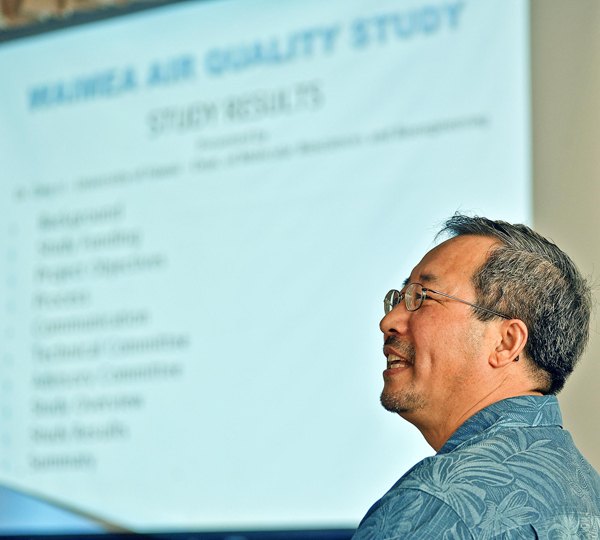WAIMEA — After spending hours under fire at a Kaua‘i County Council meeting Wednesday morning and afternoon, state officials and researchers went to Waimea and faced more than 150 Westside residents who were not convinced that Cleome gynandra, locally known as stinkweed, was what made students sick at Waimea Canyon School years ago.
An air study was ordered after nine cases of people becoming ill in Waimea between November 2006 and April 2008 — including two major events involving up to 100 schoolchildren.
The study showed toxicity levels from pesticides did not present safety concerns, and that about half of the 29 major chemical components of stinkweed were present.
And that was the conclusion that the $150,000 study came up with.
The studies were led by Dr. Qing Li, from the University of Hawai‘i Biomolecular Science Division, and his assistant, Jun Wang. The $50,000 county-funded study concentrated on identifying odorous compounds found in stinkweed. The Hawai‘i Department of Agriculture’s $100,000 study focused on pesticides detected in Waimea ambient air.
Waimea residents said more can be done to identify and control what is being sprayed and pushed for adequate warnings.
Based upon the findings, Li said the data show the air has low toxicity levels and appears to be safe.
But just like the in the council meeting earlier in the day, Li could not point to the source of the problem.
He said the study’s results do not offer room for recommendations, but encouraged dialogue between seed companies and the community.
“It appears to me there is a need for communication between the companies and the communities,” Li said. “The point is that without communities, there are no companies, and this is where the problem occurs.”
Stinkweed
Li said to his knowledge there were no incidents in the past four years, and that the initial investigation indicated a potent level of stinkweed that may have resulted from pesticide use and was a basis for the study.
Wendy Tannery, a teacher who was outside with Waimea Canyon Middle School students eight years ago, said she has since left the school, and believes the students were exposed to something other than stinkweed.
An avid horseback rider, Tannery said she was well aware of stinkweed and that it was not what she smelled in the air that day, and wanted to know why no one took residue samples for the two days following the event.
Ann Kam, a Kaua‘i pesticides inspector for HDOA, said after tilling and an unusually heavy rain, the weed was flushed out from the fence line to the road from Oct. 3, 2006 up to and including an incident date of Nov. 14, 2006.
“This weed was in all its glory and giving off this odor,” Kam said. “To my knowledge, there had never been a flush like that before.”
As an invasive weed, stinkweed was significant to the exposure study because people would be using chemicals to kill it, Li said.
The daytime levels are much higher because the light creates a reaction in plants, and gives off natural chemicals in a process.
“We are all exposed to chemicals, including pesticides,” Li said. “The point is at what levels, as the dose makes the poison, and the toxicity.”
Samuel Shaw asked if there were any recorded medical incidents of a mass poisoning caused by stinkweed, but Li said he was not aware of any.
Waimea resident Bruce Pleas, who volunteered with the study, said he convinced Li to leave the passive air samplers at the schools so the students could learn about science by maintaining them and changing filters. Should another incident occur, then it would hopefully detect the presence of the chemicals.
Pleas said that the community should not pay the bill for long-term testing and said they will ask the corporations that bring the chemicals to Kaua‘i for that support. He also said a rapid response plan should be incorporated for future incidents.
The scientists also reviewed historical records of pesticide use and selected the top 24 active ingredients that exist in more than 100 pesticide products used on island. Attendees asked about cumulative exposure over a long period of time. Others felt there are unique disease clusters and demanded medical studies instead of abstracts.
Gordon Labedz, of Kekaha, said Li is a chemist and not a toxicologist, and that questions should be addressed accordingly. The bottom line is that the study shows there are pesticides in the air of Kekaha that are not present in other areas on the island, he said.
In some ways, what happened in Waimea may be a sad fact of life, just as the spraying and burning of sugar cane fields decades ago was to another generation, said George Costa, director of the county Office of Economic Development. It is not possible to replicate the circumstances of the incidents for the study, and that continued air quality testing will help to ensure it won’t happen again.
“The question is where do we go from here?” Costa said. “In four years there have been no incidences and we want to make sure that continues.”
Pesticide study
Thomas Matsuda, pesticides branch administrator at HDOA, spoke about the permitting process for applying Restrictive Use Pesticides. He said today’s organic and synthetic pesticides and insecticides are highly targeted and use less agent to be more effective and dissipate quickly.
There is only one staff on Kaua‘i to inspect and enforce licensed product use and sales, in addition to handling all complaints, he said. The officer also collects test samples for exposure and drift studies.
“Worker protection standards are so important,” Matsuda said, noting that the Federal Insecticide, Fungicide and Rodenticide Act is the department guideline for inspecting active and inert ingredient compliance.
“The label is the law,” he said. “There are 282 restricted use pesticides in Hawai‘i, out of 8,555 types in general use.”
Peter Thielen, of Kekaha, said he was concerned that inspectors limit testing according to labels and sales records. He said that fertilizers and bleaching agents are pesticides in products that list them as such, but that they are regulated as products sold for other purposes.



